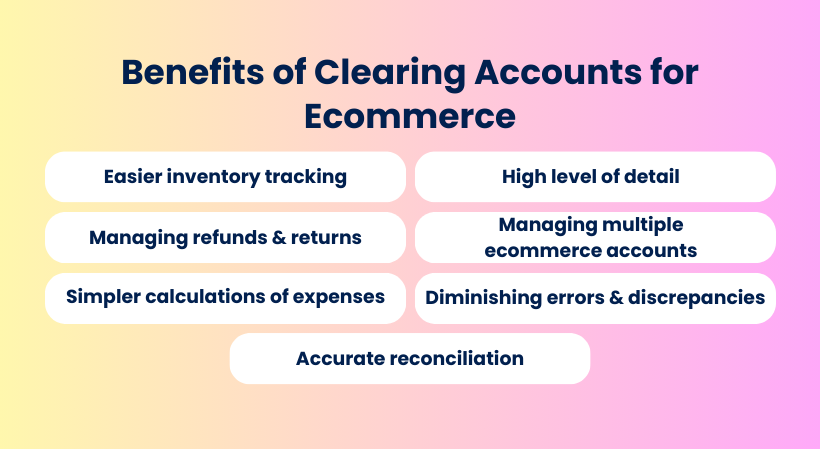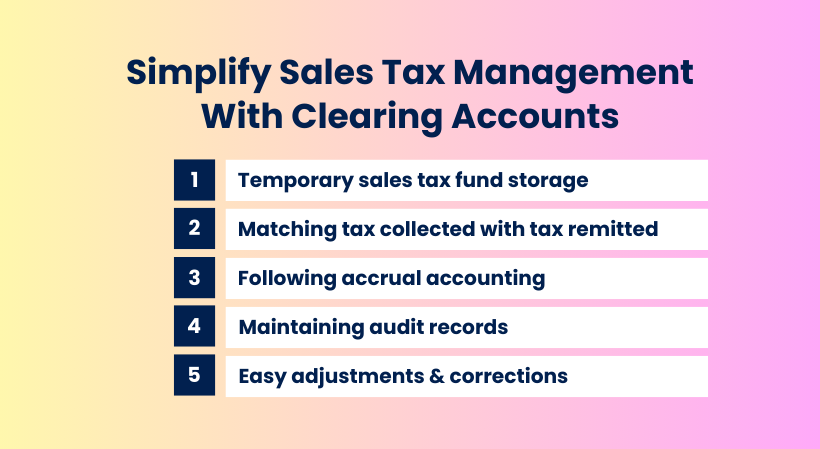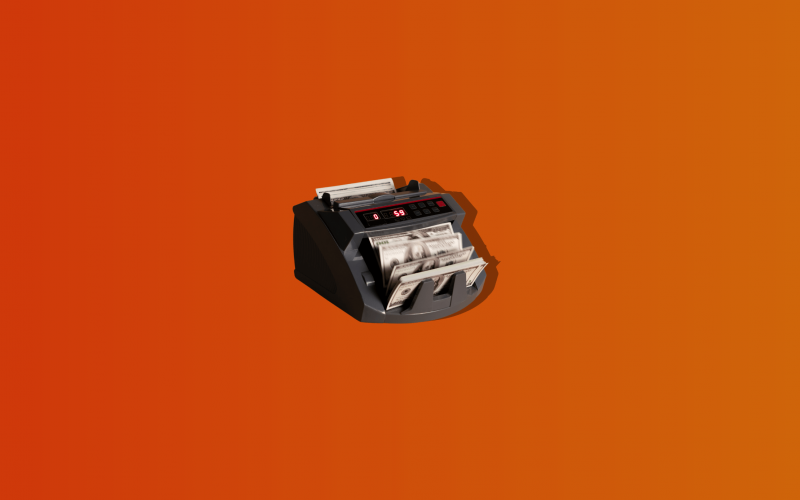If your head is spinning from the number of accounts your business has and the ensuing reconciliation issues, this article will provide insight into solving them—at least when it comes to understanding what a clearing account is and how any ecommerce business can benefit from it.
Key takeaways:
- Clearing accounts temporarily store financial transactions before they are permanently recorded elsewhere.
- They help organize and categorize transactions, aiding in accurate reconciliation and tracking.
- They’re beneficial for inventory tracking, managing refunds, simplifying expense calculations, reducing errors, and providing high detail in financial records.
- Synder, an accounting automation software, automatically creates clearing accounts, streamlining reconciliation processes for ecommerce businesses.
- Understanding the differences between clearing accounts and checking accounts is essential for efficient financial management.
Contents:
3. The difference between a clearing and checking account
4. Benefits of using a clearing account for your ecommerce business
6. Clearing reconciliation in QuickBooks
8. Wrapping up
9. FAQs
What is clearing account?
Sometimes there is a need for a safe buffer space for different types of transactions that have not yet taken place or require some type of specific detailing or processing.
Here, information about financial movements is kept temporarily until it is smoothly transferred to the main account.
Thus, a clearing account helps segregate transactions from the principal accounting ledger.
Definition
According to the Accounting Coach dictionary, a clearing account is:
“A general ledger account which serves to summarize similar transactions.”
Typically, clearing accounts contain amounts that are to be transferred to another account at a later stage.
For example, an account with revenue and expense amounts that are to be transferred to retained earnings at the close of a fiscal period.
Related terms for a clearing account you can encounter:
- zero-balance account,
- temporary account,
- buffer account,
- wash account,
- summary account,
- holding account.
These clearing accounts (can be just one or many) can be сreated for you automatically.
Are you curious about how it works? Do you want to reconcile in one click? Then get comfortable, and we’ll tell you everything step by step, but briefly.
Automatic creation with Synder accounting app
Picture this: You are looking for an easy way to communicate your Shopify stores with QuickBooks Online company. With Synder’s Shopify integration, all your sales and expenses will be automatically recorded and prepared for one-click reconciliation in your QuickBooks.
The software allows multicurrency accounting for your Shopify payments and Shopify orders paid via alternative payment providers like Stripe, PayPal, etc., providing accurate records of your Shopify sales, processing fees, taxes, customers, discounts, and other transaction details. Synder will help you track inventory in QuickBooks and categorize all synced data automatically to keep your books up-to-date and precise.
Upon connecting your platforms to Synder for the first time, a clearing account is automatically generated in the ‘Chart of Accounts.’ This action enables Synder to mirror real-world money flows accurately. It temporarily holds the records of transactions synced into the system, for example, from an ecommerce platform, a payment processor, or something similar. It does opening balance equity.
Are you an ecommerce business? If you want to improve your ecommerce accounting, sign up for a free trial or book a spot at the Weekly Public Demo to understand how Synder can help you stay on top of accurate reporting, flawless reconciliation, and a smooth tax season.
What is the purpose?
The purpose of this type of account is to set aside the payment details before the ultimate transaction finalization.
1. How do accountants use clearing accounts?
Accountants use clearing accounts to store money-in and money-out information for a short period of time until everything is ready to be officially registered in the permanent records.
Also, accountants use these types of accounts to ensure accurate recording & tracking of transactions involving multiple steps or parties. This helps reconcile discrepancies and ensures that transactions are properly allocated before they are finalized in their respective accounts.
2. How do businesses use clearing accounts?
Businesses can use these types of accounts to document all sales, items, fees, shipping details, taxes, or other expenses that have not yet been fully and properly accounted for.
A clearing account can also be very helpful in managing accounts receivable, making it an essential part of AR automation (let’s say, in the case of unpaid invoices).
Generally speaking, it’s useful anytime a business or an accountant wants to deal with certain types of transactions or keep some specific money flow details separate before balancing the sheets.
The general flow looks like this:
- Enter transactions into a safe buffer space.
- Zero out the balance.
- Move transactions to the principal account.
But let’s see it in more detail.
How does it work?
A clearing account helps businesses and accountants temporarily record financial transaction details. It’s created to record income or expenses before they are transferred to retained earnings in the balance sheet.
Clearing accounts are “cleared” systematically using ACH technology. This means that all of the data from this account is transferred to another place, and the balance becomes equal to zero. The account can get cleared:
- at the end of the fiscal year,
- monthly,
- or sometimes even daily.
For example, a clearing account used to record utility expenses may be closed monthly, whereas an account of daily cash receipts might be closed each day.
When the balance of the clearing account is perfectly zeroed, then you know that your bookkeeping is done correctly. All information can be registered in the main accounting ledger without errors.
Managing payment gateways with Synder
Synder creates clearing accounts in your QuickBooks or Xero accounting system that reproduces the real money flows from any payment gateway.
There is a vast list of ecommerce platforms or payment providers with which Synder can integrate. If not, you can always import payments from Excel. So, technically any gateway you can possibly receive payments from can be accounted for by Synder.
Let’s simulate the situation, shall we?
Let’s say your business receives payments via Stripe from a customer. The money gets transferred from the customer’s Stripe account to yours and is kept there for some time. You can’t see them on your real bank account or manage this money for a moment.
That is how a clearing account reflects a real-life situation and plays the role of a payment provider in the accounting system. The clearing accounts created by Synder will also be named after the payment provider, e.g. the ‘Stripe bank account.’
The balance of this clearing account allows you to easily track whether all transactions are in the accounting.
If all types of transactions are synced, all sales and payouts, then the balance of the clearing account in your QuickBooks or Xero will be equal to the Stripe account balance (or whichever gateway is connected).
The difference between a clearing and checking account
Now you know that funds are stored in the clearing account for a short time before being relocated elsewhere. Where do they go?
In Synder, transactions from the clearing account go to your checking account. So, it’s important to understand the difference between these two types of accounts.
Synder automation software uses the flow with a clearing account instead of just syncing deposits to a checking account. This achieves a high level of accuracy in reconciliation and makes the process easier.
Checking account definition
A checking account is a bank account that allows you to withdraw and deposit money.
Related terms for a checking account are:
- current account,
- bank account,
- transactions account,
- deposit account.
In your accounting software, a checking account is your current bank account that you connect to the accounting system and use for money transfers and reconciliation.
Clearing vs checking account
Now, we’ll compare the clearing and checking accounts across some parameters.
| Aspect | Clearing account | Checking account |
| Purpose | Used as a buffer account within the accounting software to temporarily hold transaction data. | Represents a real account held in a bank and linked to the accounting software. |
| Data retention | Primarily retains transaction information, serving as a bridge between different accounts. | Stores both real money and transaction information, accurately reflecting the company’s financial status. |
| Transaction flow | Transactions recorded in the clearing account are temporary and are typically transferred to other accounts later. | Transactions recorded in the checking account are permanent and directly impact the company’s cash balance. |
| Financial status | Essential for organizing and categorizing transactions before they are permanently recorded in the ledger. | Facilitates everyday financial activities such as payments, deposits, and withdrawals, offering real-time access to funds. |
Benefits of using a clearing account for your ecommerce business
Ecommerce businesses can benefit largely from using clearing accounts in their bookkeeping.
Here are some of the reasons why.

- Easier inventory tracking. For the purpose of inventory tracking and fulfillment, it’s common for an ecommerce business to record the initiation of the sales process and relief of inventory well before the final deposit.
- Managing refunds & returns. When saved to the clearing account, expense or refund information can be processed and matched to the existing transactions before they are deposited or reconciled to the bank.
- Simpler calculations of expenses. The advantages of the clearing account extend to almost all types of expenses and payments, starting with sales tax and ending with processing payroll.
- Diminishing errors & discrepancies. Clearing accounts are used separately from the main ledger and the actual checking account. This helps reduce the possibility of unwanted mistakes in reporting to the minimum.
- High level of detail. Using a clearing account as a buffer allows business owners and accountants to match all kinds of financial details in a “buffer” mode. The balance of the clearing account helps identify issues if that’s the case. If something doesn’t match, tracking what is missing is easier.
- Managing multiple ecommerce accounts. Synder creates a separate clearing account in your accounting system for each ecommerce business (if you have many) or a payment processor.
For example, you can have one clearing account for Shopify payments, another for PayPal, and another for Stripe transactions. This separation of money flows facilitates the bookkeeping process by helping to identify issues and discrepancies precisely. - Accurate reconciliation. Clearing accounts is trouble-free, as you are not afraid to mess up the books. Issues or missing transactions can be easily identified. Reconciliation is successful if all transactions match and the account clears to a zero balance.
Setting up a clearing
It is easy to set up a clearing account when you use Synder, a piece of cloud or desktop accounting software that streamlines financial processes. You just connect your preferred accounting software: QuickBooks Online, QuickBooks Desktop, or Xero. And the software does everything for you.
You only check the state of your account periodically and accomplish your clearing account reconciliation. After this period, a zero balance remaining in your clearing account means that your reconciliation has been completed successfully and no issues were detected in your books.
How does a clearing account work for the QuickBooks integration?
Synder can supercharge your accounting and make bookkeeping and financial reporting easier for business owners and professional accountants.
Here is an outline of how a clearing account works for the QuickBooks integration:
- Synder creates a clearing account for you once the connection with the accounting and payment platforms has been made.
- This account becomes one of Synder’s two accounts within QuickBooks: a clearing and a checking account to which your bank feed is connected.
- The software uses it for recording sales transactions, fees, and refunds (so you have the correct gross and net income amount recorded).
- Then this clearing account is to be reconciled with the payment processor and your checking account.
Clearing reconciliation in QuickBooks
Once all payment details, including refunds, payment fees, and the original sale information, have been entered into the clearing account in your QuickBooks, it’s time to match transactions and reconcile the data.
How it happens:
- When a payment processor (for example, Stripe or PayPal) sends a payment settlement for a certain amount to your real bank, Synder reflects this by making a transfer from the clearing to your checking account for exactly the same amount.
- QuickBooks pre-matches it to the bank statement line like it basically makes a guess that this or that statement line may be this or that transaction that is created in a checking account,
- QuickBooks automatically highlights those pieces that match, and all you need to do is click ‘Match’ or ‘Confirm’ to finish the process.
Synced vs cleared vs reconciled transactions
Now, you may be wondering how to find transactions synced by Synder in your accounting and what their status is.
Look for the results of synchronization directly in your accounting system:
- When transactions appear in Synder with the green status ‘Synced,’ the system synchronizes them into your books. You can now find them in the clearing account in the ‘Chart of Accounts’ in QuickBooks or Xero.
- After you click to reconcile transactions, you will see the status ‘Matched’ or ‘Confirmed.’ This means that the transactions have been reconciled with your bank account connected to the accounting.
- Finally, once the transactions have been reconciled, they move from the clearing account to the checking account, which means they are cleared.
After understanding the concepts of synced, cleared, and reconciled transactions, you might want to delve deeper into how Synder facilitates reconciliation & categorization for your Profit and Loss (P&L) statements in more detail.
Check out our video tutorial for a comprehensive walkthrough on this topic.
Discovering other uses
In accounting, clearing accounts play a key role in managing sales tax transactions. They help keep track of the taxes collected from sales and ensure they’re properly accounted for until they’re sent to the tax authorities. Here’s how clearing accounts make dealing with sales tax simpler.

- Temporary sales tax fund storage. When customers pay sales tax along with their purchases, businesses temporarily hold these funds in clearing accounts. This separation prevents tax money from mixing with regular revenue, making it easier to use these funds solely for tax purposes when needed.
- Matching tax collected with tax remitted. Clearing accounts help reconcile the taxes collected from sales with the taxes sent to tax authorities. By keeping a clear record of tax collections in these accounts, businesses can quickly compare them with their tax payment records. This ensures they’re sending the right amount of sales tax, avoiding errors in reporting.
- Following accrual accounting. For businesses using accrual accounting, it’s essential to record revenue and expenses when they occur, not just when money changes hands. Clearing accounts help align sales tax transactions with this principle. Until businesses send the collected taxes to the authorities, these accounts show them as liabilities, reflecting their true financial status.
- Ensuring compliance & maintaining audit records. Clearing accounts provide a clear record of all sales tax transactions, from collection to remittance. This transparency helps businesses comply with tax regulations and easily prove their tax filings during audits. Having detailed tax records in clearing accounts simplifies both internal and external audits.
- Easy adjustments & corrections. If mistakes are made when recording sales tax transactions, clearing accounts offer a straightforward way to adjust or correct sales tax records. Businesses can adjust the tax records within these accounts without affecting other financial accounts. This flexibility allows for quick sales tax corrections, preventing errors from carrying over into future reporting periods.
By utilizing clearing accounts for sales tax management, businesses can simplify their tax processes and ensure accurate and compliant financial reporting.
Read more: Ecommerce Sales Tax: A Breakdown of Sales Taxes for Businesses Selling Online
Wrapping up
Clearing accounts give ecommerce business owners and professional accountants the flexibility that is necessary for achieving the most accurate and insightful sales information.
It is a handy tool for storing temporary transactions in a buffer space, where all entered sale and expense information can be safely reconciled without damaging the books.
Additionally, the clearing account can signal if some transactions are missing in case the balance does not zero out or match your payment provider’s account.
It becomes easy to manage finance, even with multiple ecommerce platforms and payment gateways connected, as Synder accounts for each of them in a separate clearing account created automatically for you.
FAQs
- Can clearing accounts help in adjusting errors related to sales tax transactions?
Yes, clearing accounts offer flexibility for making adjustments or corrections to sales tax records, enabling businesses to rectify errors promptly without affecting other financial accounts.
- Are clearing accounts essential for businesses following accrual accounting principles?
Yes, clearing accounts play a crucial role in aligning sales tax transactions with accrual accounting principles, ensuring that revenue and expenses are recognized when they occur, regardless of cash flow timing.
- How often should businesses reconcile their clearing accounts for sales tax?
Businesses should ideally reconcile their clearing accounts for sales tax on a regular basis, such as monthly or quarterly, to ensure accuracy and compliance with tax requirements.
- What types of transactions typically involve clearing accounts?
Transactions involving transfers between accounts, adjustments for discrepancies, and reconciliations often utilize clearing accounts to temporarily hold funds until they can be properly allocated.
- Can funds remain in clearing accounts indefinitely?
No, ideally, funds should not remain in clearing accounts indefinitely. They are meant to be temporary holding accounts, and it’s essential to reconcile and clear them regularly to maintain accurate financial records.
- What happens if funds remain in a clearing account for an extended period?
If funds remain in a clearing account for an extended period, it can lead to discrepancies in financial reporting and inaccurate financial statements. It’s important to investigate and resolve any outstanding items promptly.

.png)





I appreciated you pointing out that a checking account allows you to withdraw and deposit money. My friend wants to be able to withdraw money. I should advise her to open a checking account from her trusted bank.
Hi Victoria, thank you for your comment, we are glad we could help!